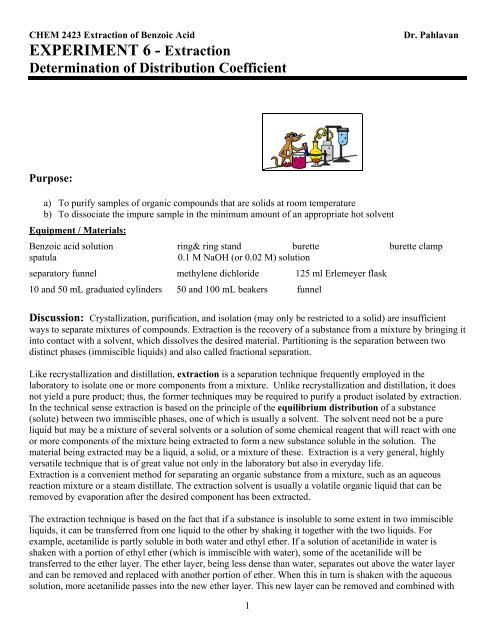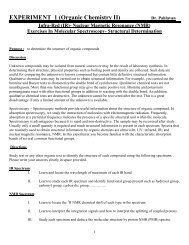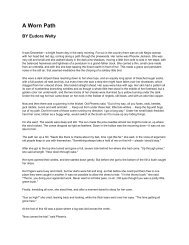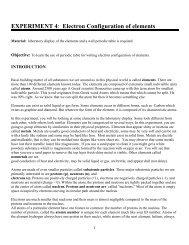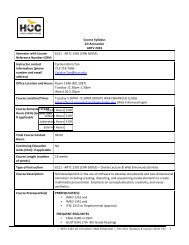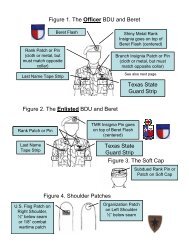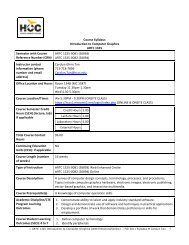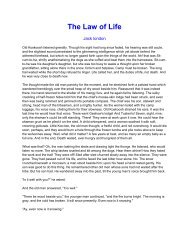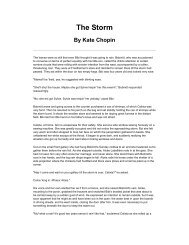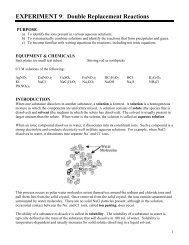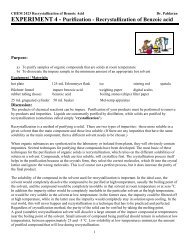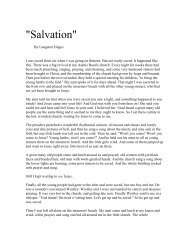EXPERIMENT 6 - Extraction
EXPERIMENT 6 - Extraction
EXPERIMENT 6 - Extraction
- No tags were found...
Create successful ePaper yourself
Turn your PDF publications into a flip-book with our unique Google optimized e-Paper software.
CHEM 2423 <strong>Extraction</strong> of Benzoic Acid<strong>EXPERIMENT</strong> 6 - <strong>Extraction</strong>Determination of Distribution CoefficientDr. PahlavanPurpose:a) To purify samples of organic compounds that are solids at room temperatureb) To dissociate the impure sample in the minimum amount of an appropriate hot solventEquipment / Materials:Benzoic acid solution ring& ring stand burette burette clampspatula0.1 M NaOH (or 0.02 M) solutionseparatory funnel methylene dichloride 125 ml Erlemeyer flask10 and 50 mL graduated cylinders 50 and 100 mL beakers funnelDiscussion: Crystallization, purification, and isolation (may only be restricted to a solid) are insufficientways to separate mixtures of compounds. <strong>Extraction</strong> is the recovery of a substance from a mixture by bringing itinto contact with a solvent, which dissolves the desired material. Partitioning is the separation between twodistinct phases (immiscible liquids) and also called fractional separation.Like recrystallization and distillation, extraction is a separation technique frequently employed in thelaboratory to isolate one or more components from a mixture. Unlike recrystallization and distillation, it doesnot yield a pure product; thus, the former techniques may be required to purify a product isolated by extraction.In the technical sense extraction is based on the principle of the equilibrium distribution of a substance(solute) between two immiscible phases, one of which is usually a solvent. The solvent need not be a pureliquid but may be a mixture of several solvents or a solution of some chemical reagent that will react with oneor more components of the mixture being extracted to form a new substance soluble in the solution. Thematerial being extracted may be a liquid, a solid, or a mixture of these. <strong>Extraction</strong> is a very general, highlyversatile technique that is of great value not only in the laboratory but also in everyday life.<strong>Extraction</strong> is a convenient method for separating an organic substance from a mixture, such as an aqueousreaction mixture or a steam distillate. The extraction solvent is usually a volatile organic liquid that can beremoved by evaporation after the desired component has been extracted.The extraction technique is based on the fact that if a substance is insoluble to some extent in two immiscibleliquids, it can be transferred from one liquid to the other by shaking it together with the two liquids. Forexample, acetanilide is partly soluble in both water and ethyl ether. If a solution of acetanilide in water isshaken with a portion of ethyl ether (which is immiscible with water), some of the acetanilide will betransferred to the ether layer. The ether layer, being less dense than water, separates out above the water layerand can be removed and replaced with another portion of ether. When this in turn is shaken with the aqueoussolution, more acetanilide passes into the new ether layer. This new layer can be removed and combined with1
CHEM 2423 <strong>Extraction</strong> of Benzoic AcidDr. Pahlavanthe first. By repeating this process enough times, virtually all of the acetanilide can be transferred from thewater to the ether.As we stated above, the substance being extracted may be a solid. <strong>Extraction</strong>s of this type will not beconducted here, but they are probably already a part of your own experience. The brewing of tea from tealeaves (or the tea bag that combines extraction and filtration) and of coffee from the ground bean are excellentexamples of the extraction of a solid mixture with a hot solvent (water).In the laboratory one of the more important applications of the extraction process has been its use to remove anorganic compound from a solution when distillation is not feasible. <strong>Extraction</strong> is accomplished by shaking thesolution in a separatory funnel with a second solvent that is immiscible with the one in which the compound isdissolved, but dissolves the compound more readily. Two liquid layers are formed, and the layer that has mostof the desired product in it can be separated from the other. Sometimes not the entire product is extracted in asingle operation and the process must be repeated once or twice more to assure a clean separation. It has beenfound that when two immiscible solvents are shaken together, the solute distributes itself between them in aratio roughly proportional to its solubility in each. The ratio of the concentration of the solute in each solvent atequilibrium is a constant called the distribution ratio(d) or partition coefficient (K d ).The larger the value of K d , the more solute will be transferred to the ether with each extraction, and the fewerportions of ether will be required for essentially complete removal of the solute.K d=[solute] o[solute]aq=C oC aq=W o /V oW aq /V aqwhere o and aq refer to the organic (ether) and aqueous layers, respectively, and W o and W aq are the weights ingrams of material dissolved in each respective layer.C o = concentration of organic solution and C aq = concentration of aqueous solutionExample (1) - Give at 20 o C only 0.24 g of an organic acid “A” dissolves in 100 ml of water, but 2.70 g of thesame acid dissolves in 100 ml of ether.a) calculate the value of partition coefficient.[solute] o C o WK d== = o /V o[solute] Caq aq W aq /V aqK d = (2.70 g/ 100ml) / (0.24 g/100ml) = 11.25b) calculate the percentage of extraction if 0.12 g of acid extracted in 100 ml of aqueous solution.K d = ( X o / 100)/(0.12/100) 11.25 = (X o /0.12)Xo = 11.25 x 0.12 = 1.35 g, acid extracted in organic phaseXtotal = X o + X aq = 1.35g + 0.12 g = 1.47 g% Ex = ( X o / X total ) x 100 = (1.35 / 1.47) x100 ≈ 92 %c) calculate the volume of ether required to extract 85% of a 3.00 g of acid “A” in 100 ml solution.X o = (85%)x 3.00 g = 2.55 g , X aq = 3.00g – 2.55g = 0.45 g remained in aqueous solution2
CHEM 2423 <strong>Extraction</strong> of Benzoic Acid11.25 = ( 2.55/V o ) / (0.45 /100) V o ≈ 51 mlDr. Pahlavand) calculate the total amount of acid extracted by a double extraction of 50 ml ether in each extraction inpart ( c).First extraction (first 50 ml ether)11.25 = ( X o1 /50) / (X w1 /100) 11.25 = ( X o1 /50) / (3.00 –X o1 /100) , solve for X o1X o1 = 2.57 g acid extracted in first extractionX w1 = 3.00 g – 2.57 g = 0.43g acid remained in aqueous solution after first extractionSecond extraction (second 50 ml ether)11.25 = ( X o2 /50) / (X w2 /100) 11.25 = ( X o1 /50) / (0.43 –X o2 /100), solve for X o2X o2 = 0.38 g acid extracted in first extractionX o (total) = X o1 + X o2 = 2.57 g + 0.38 g = 2.93 g%E = (2.93 /3.00) x100 = 97.7 %Or use the following formula;%E = [ 1 - (V aq / V aq + K d V o ) n ] x 100 , where n is the number of extraction.%E = [ 1 - ( 100/ 100+11.25x50) 2 ] x100 = 97.7 %Example (2) – Isobutyric acid has a solubility in water (at 25 0 C) about one-third of its solubility in diethylether; thus K d = 3.0. Imagine 4.0 g of isobutyric acid dissolved in a mixture of 35.0 ml of diethyl ether and100.0 ml of water.a) What weight of acid is in each layer at equilibrium after first extraction and second extraction?b) Calculate the percentage extraction after second extraction.Solubility of butyric acid in water = X g/mlSolubility of butyric acid in diethyl ether = 3X g/mlFirst <strong>Extraction</strong>X w = V w . X = (100.0 ml)(X g/ml) = (100.0) XX o = V o . 3X = (35.0 ml)( 3X g/ml) = (105.0) XX w + X o = 4.0 g 4.0 = (100.0) X + 105 X 4.0 = 205.0 X X = 0.0195 gX w(1) = (100.0) X = (100.0)(0.0195) = 1.95 g (remained in water after first extraction)X o(1) = (105.0) X = (105.0)(0.0195) = 2.05 g (extracted by diethyl ether after first extraction)3
CHEM 2423 <strong>Extraction</strong> of Benzoic AcidDr. PahlavanSecond <strong>Extraction</strong>1.95 = 205.0 X X = 0.00951X w(2) = (100.0) X = (100.0)(0.00951) = 0.951 gX o(2) = (105.0) X = (105.0)(0.00951) = 0.999 g(remained in water after second extraction)(extracted by diethyl ether after second extraction)%E = [( X o(1) + X o(2) )/ X total ) x100 = [(2.05 + 0.95)/ 4.0) x100 = 76 %<strong>Extraction</strong> solventsIf a solvent is to be used to extract an organic compound from aqueous mixture or solution, it must be virtuallyinsoluble in water, and it should have a low boiling point so that the solvent can be more soluble in theextraction solvent than in water, since otherwise too many extraction steps will be required to remove all of thesolute.Ethyl ether is the most common extraction solvent. It has a very low boiling point ( 34.5 ° c) and can dissolve alarge number of organic compounds, both polar and nonpolar. However, ethyl ether must be used with greatcare, since it is extremely flammable and tends to form explosive peroxides on standings.Methylene Chloride (dichloromethane) has most of the advantage of ethyl ether; in addition, it is nonflammableand denser than water. However, it has a tendency to form emulsions, which can make it difficult to separate thelayers cleanly. Other useful solvents and their properties are listed in the following table. Various grades ofpetroleum ether (a mixture of low boiling hydrocarbons) can be used in place of pentane.From the foregoing discussions some of the desirable properties of an organic extraction solvent becomeapparent. (1) It must readily dissolve the substance being extracted but must not dissolve to any appreciableextent in the solvent from which desired substance is being extracted. (2) It should extract neither the impuritiesnor other substances present in the original mixture. (3) It should not react with the substance being extracted.(4) It should be readily separated from the desired solute after extraction. Few solvents will meet all of thesecriteria, and in some cases a completely satisfactory solvent cannot be found. Therefore, the scientist mustselect a solvent system that most nearly approaches the ideal.Some of the solvents commonly used for extracting aqueous solutions or mixtures include diethyl ether,methylene chloride, chloroform, carbon tetrachloride, benzene, n-pentane, n-hexane, and various mixtures ofsaturated hydrocarbons from petroleum (petroleum ether, ligroin, etc.). Each of these has a relatively lowboiling point so that it may be fairly easily separated from the solute by evaporation or distillation. Methanoland ethanol are not good solvents for extracting aqueous solutions or mixtures because of their solubility inwater; however, if an aqueous solution can be saturated with potassium carbonate without affecting the solute,ethanol can be used to extract polar solutes from the solution.4
CHEM 2423 <strong>Extraction</strong> of Benzoic AcidProperties of commonly used extraction solventsDr. PahlavanSolvent b.p. (°C ) D (g/ml) CommentsEthyl acetate 77 0.90 Absorbs much of water goodEthyl ether 34.5 0.90 general solvent; absorb some water,easy to remove; very flammable;vapor should not be inhaledMethylene dichloride 40 1.34 Good general solvent; easy to dryand remove; suspected carcinogenChloroform 62 1.48 Can form emulsion easy to dry andremove; health hazard; suspectedCarcinogen1,1,2-trichlorotri- 48 1.58 Maybe substituted for carbonFluroethane (Freon TF)tetrachloridePentane 36 0.63 Easy to dry & remove; veryFlammableHexane 69 0.66 Easily driedExtract SolventsSolvent Solubility in Water (g/100 ml) Fire hazard ToxicityPetroleum ether Low High LowLigroin Low High LowHexane 0.02 High LowEthyl ether 6 High LowToluene 0.06 Medium MediumWater Infinite None NoneSaturated NaCl (aqueous) Infinite None NoneMethylene chloride 2 Low MediumCriteria for selecting an extracting solvent1) It should be insoluble or slightly soluble with the solvent of the solution being extracted.2) It should have a favorable distribution coefficient for the substance being extracted and an unfavorabledistribution.3) It should be able to be easily removed from the extracted substance after the extraction.Since the removal is often by distillation, the solvent should therefore have a reasonably low boilingpoint.4) It should be chemically inert to the extracted substance, other components in the mixture,and the solvent to the solution being extracted.5) It should be reasonably safe to work with and relatively inexpensive.5
CHEM 2423 <strong>Extraction</strong> of Benzoic AcidUse of the Separatory FunnelDr. PahlavanThe procedure in this experiment involves the use of the separatory funnel. It is important that you learn how touse this piece of equipment properly, for an efficient separation and for safety. It is made of thin glass and iseasily broken unless handled carefully. Unfortunately, in various student manuals you will find descriptions ofabout as many ways of holding the separatory funnel as for holding a pair of chopsticks. Probably for you thereis some best method, depending on the size of your hands, the strength of your fingers, your manual dexterity,and the size and shape of the funnel. The following are important rules to observe.1. Hold the funnel firmly but gently in both hands so that it can be turned from the vertical to horizontaldirection and back again easily and can be shaken vigorously while observing (2) and (3).2. Keep the stopper tightly seated with one hand at all times, using the forefinger of that hand, the base ofthe forefinger, or the palm of the hand.3. Keep the stopcock tightly seated with the fingers of the other hand in such a way that the fingers canopen and close the stopcock quickly to release the pressure that may be built up from solvent vapor orevolved gases.The use of the separatory funnel is a skill and is best learned by practice with an empty funnel while watchingyour instructor demonstrate the technique. In the figure below are shown two slightly different methods ofhandling the separatory funnel. In the first method the stem of the funnel projects between the thumb and firstfinger of the left hand (for a right-handed person). The stopcock is held in place and operated with the thumband first finger. The stopper is kept in place by pressure against the base of the first finger of the right hand.In the second method the stem of the funnel projects between the first and second fingers of the left hand. Thestopcock is held in place by the pressure from these fingers and is operated by them in conjunction with thethumb. The stopper is held in place by pressure against the middle of the palm of the right hand. (Fig 1)shakeshakeFig. 1- methods for holding and shaking the separatory funnel. Fig. 2- support and use of the separatory funnel.Support the separatory funnel in a ring on ring stand. Close the stopcock and add the liquids to the funnel to beseparated. Insert the stopper, and immediately invert the funnel. Point the barrel away from your face andthat of your neighbors. Open the stopcock to release the pressure, which may have accumulated inside thefunnel (volatile solvents such as ether develop considerable pressure).Close the stopcock and, holding the funnel horizontally, shake the funnel two or three times. Invert the funneland release the pressure as before. Repeat this process until opening the stopcock causes no further pressurerelease. Close the stopcock and shake the funnel 15-20 times. Replace the funnel in the holder (ring on ringstand) and remove the stopper (Fig. 2). Allow the liquids to stand until the layers have completely separated.Draw the lower layer into a flask or beaker of proper size (see figure below).6
CHEM 2423 <strong>Extraction</strong> of Benzoic AcidDr. PahlavanDo not draw the liquid through the stopcock too rapidly. Slow the flow carefully as the boundary between thetwo layers approaches the stopcock. Stop the flow of liquid completely just as the upper layer enters the hole inthe stopcock. Pour the upper layer through the neck of the funnel into a second flask. Never discard eitherlayer until you are absolutely certain which is the proper layer to keep. Usually one layer will be an aqueouslayer or solution, and the other will be an organic liquid. The one of greater density will be on the bottom.To check the identity of a layer, should you be in doubt, withdraw a few milliliters of the lower layer into a testtube containing an equal volume of water. If the lower layer in the separatory funnel is water or an aqueoussolution it will be homogeneous (only one layer). If the layer being tested is the organic layer, the samplewithdrawn will fall to the bottom of your test tube and also form two liquid layers. In either event, return thetest mixture to the separatory funnel.Experimental ProceduresPart 1 – Standardization of NaOH solutionUse a 10 mL graduated cylinder measure 10.0 ml of the acid solution and transfer the solution to a 125 mLErlenmeyer flask. Add 2-3 drops of phenolphthalein and titrate to the end point(light pink) with a standardized(≈ 0.1M or 0.02 M) sodium hydroxide solution. Record in report form the number of milliliters of base requiredto neutralize this volume of acid solution. Calculate the molarity of the NaOH.Discard the neutralized acid solution and rinse your flasks. REPEAT.(TWO TRIALS)Part 2 – Single extractionUse a 50 mL graduated cylinder to measure out a second 50.0 ml volume of acid solution and transfer it to yourseparatory funnel. Add 10 ml of methylene dichloride, CH 2 Cl 2 , to the funnel and extract according to theprocedure outlined in the part 1 of this experiment. Separate the bottom layer (organic phase) in a 100 mLbeaker and collect the top layer(aqueous) into a 125 mL Erlenmeyer flask and add 2-3 drops of indicator.Record the volume of the sodium hydroxide solution in the burette and titrate to the phenolphthalein end point(light pink). Again record the number of milliliters of base required and calculate a-g. Discard the neutralizedacid solution and the methylene dichloride layer into the large bottle marked "Organic Waste".NOTE:This lab has been modified in that methylene dichloride is now used in place of ether as the organicphase. This avoids the problem of ether fumes and explosions. However, the extraction with methylenedichloride is not as clean because methylene dichloride is more miscible in water than ether. As a result, youwill find that your aqueous layer is cloudy after extraction. You can still titrate the aqueous layer to a light pinkendpoint.Part 3 - MultiextractionRepeat the procedure from Step 2, but this time extract 50 ml of fresh acid solution with two 5 ml portions ofmethylene dichloride. Separate the aqueous layer into a flask and dispose of the organic layer. Transfer theaqueous layer back into the empty, cleaned, separatory funnel and extract it with a second 5 ml portion offresh methylene dichloride. Separate the extracted aqueous layer, add indicator as before and titrate to theend point. Record the volume of standard base required and calculate a-f. Dispose of the organic layer extractsas directed and clean your separatory funnel.7
CHEM 2423 <strong>Extraction</strong> of Benzoic AcidLaboratory –EXP 6Data and Results (<strong>Extraction</strong> of Benzoic Acid)Date:____________Name:Lab Report: _______Dr. PahlavanPart 1: Standardization of NaOH Solutiona. Volume of base required to neutralize 10.0 ml of the benzoic acid solution:Trial 1: _____ml Trial 2: _____ml Average: _____ mlb. Molarity of the NaOH solution:(ml of base) (M of base) = (ml of acid) (M of acid)Calculation:__________MPart 2:Distribution Coefficenta. Volume of base required to neutralize 50 ml of benzoic acid solution after a singleextraction with 10.0 ml 0f CH 2 Cl 2__________ mlb. Moles of benzoic acid neutralized: (2a in L) (1b) __________ moleCalculation:c. Grams of benzoic acid neutralized: (2b) (MW of benzoic acid) __________ gCalculation:d. Grams of benzoic acid originally present in 50 ml before extracting with CH 2 Cl 2 : 0.122 g0.61 g/250 ml = x/50 ml, x = 0.122 ge. Grams of benzoic acid extracted in CH 2 Cl 2 : (2d – 2c) __________ gCalculation:f. Percent of benzoic acid in extracted in CH 2 Cl 2 : (2e/2d) x 100 __________ %Calculation:g. Distribution coefficient K d = C C H2 Cl2 /C H2O : (2e/10 ml)/ (2c/50ml) __________Calculation:8
CHEM 2423 <strong>Extraction</strong> of Benzoic AcidDr. PahlavanPart 3:Multiple Extrationa. Volume of base required to neutralize 50 ml of benzoic acid solution aftertwo extraction with 5.0 ml of CH 2 Cl 2 each:__________ mlb. Moles of benzoic acid neutralized: (3a in L) (1b) __________moleCalculation:c. Grams of benzoic acid neutralized: (3b) (MW of benzoic acid) __________ gCalculation:d. Grams of benzoic acid originally present in 50 ml before extracting with CH 2 Cl 2 0.122 gCalculation:e. Grams of benzoic acid extracted in CH 2 Cl 2 : (3d – 3c) __________ gCalculation:f. Percent of benzoic acid in extracted in CH 2 Cl 2 : (3e/3d) x 100 __________%Calculation:Calculate amount of benzoic acid which would be extracted in two 5.0 ml extractions with CH 2 Cl 2 based onyour K d obtained in part 2:Show calculation:9
CHEM 2423 <strong>Extraction</strong> of Benzoic AcidPre-Laboratory Questions–EXP 6Due before lab begins. Answer in space provided.Name:Dr. Pahlavan1. The distribution coefficient, K , 10 for compound Y. What weight of compound Y would be removedfrom a solution of 4.0 g of Y in 100 ml water by a single extraction with 100 ml of ether?2. Reconsider question 1above; what weight of compound Y would be removed by two(double) extractions using 50 ml of ether each time?3. Student during an extraction experiment lost track of which layer is the aqueous layer. HowCould student determine which layer is which by a simple test?4. Why must the stopper be removed from the separatory funnel before the lower layer isremoved.5. An aqueous solution containing 5.0 g of solute in 100 ml is extracted with three 25 ml portion of diethylether. What is the total amount of solute that will be extracted by the ether, K = 1.0 ?10
CHEM 2423 <strong>Extraction</strong> of Benzoic AcidPost-Laboratory Questions–EXP 6Due after completing the lab.Name:Dr. Pahlavan1. What are the advantages and disadvantages of using ether as a solvent for the extraction of organiccompounds?2. What volume of an organic solvent must be used to effect 90% separation in one extraction when only2.7 g of a certain compound dissolves in 100 ml of water? (K= 15)3. What percentage of the organic compound could be recovered if two extractions were made, each timeusing half of the volume calculated 2?4. An organic compound can be extracted from a water layer by an organic solvent more efficiently if thewater layer is saturated with an inorganic salt such as sodium chloride. This effect, called “salting out”,increase the participation coefficient in favor of the organic compound. (explain)5. The pain reliever phenacetin is soluble in cold water to an extent of 1.0 g /1310 ml andsoluble in diethyl ether to an exient of 1.0 g /90ml.a) Determine the approximate distribution coefficient for phenacetin in those two solvents.b) If 150 g of phenacetin were dissolved in 100 ml of water, how much ether would be required toextract 90% of phenacetin in a single extraction?c) What percent of the phenacetin would be extracted the aqueous solution in part (b) by two 25mlportions of ether?11


